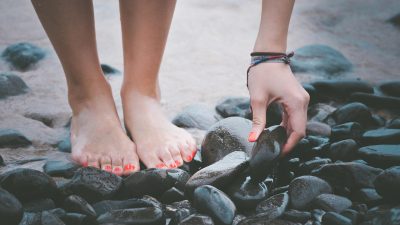Discover their hidden science, history, and even their impact on personality.
Belly buttons, or navels, are often overlooked, yet they are one of the most intriguing parts of the human body. Whether you have an innie or an outie, your belly button has a story to tell. From its formation as your first scar to its role in medical procedures and even meditation, your navel is far more than just a mark left from birth. Let’s uncover the science, myths, and surprising uses of belly buttons.
The Hidden Facts About Belly Buttons
1. Not Everyone Has a Belly Button
Most people assume that every human has a belly button, but that’s not always the case. Some individuals, like model Karolina Kurkova, lack a visible belly button due to surgical procedures—often because of an umbilical hernia at birth. This condition requires surgery, which can leave the person without a defined navel.
2. Some Mammals Don’t Have One
While most mammals have belly buttons, nature sometimes works differently. Kangaroos and platypuses don’t have visible navels because they give birth differently compared to other mammals. However, dolphins do have belly buttons, as they are also mammals and develop inside their mothers before birth.
3. Your Belly Button is Your First Scar
Your navel is actually a scar left behind when the umbilical cord is cut at birth. While many believe that doctors shape the belly button, in reality, its appearance depends on how the body heals. This explains why some people have innies while others have outies.
4. Your Belly Button is a Bacterial Wonderland
Each person’s belly button is home to thousands of bacteria species, making it as unique as a fingerprint. Scientists have discovered over 2,400 different bacteria species in human navels. Incredibly, some bacteria found in a person’s belly button have only ever been seen in soil samples from Japan, even if the person has never been there.
5. Most People Have an Innie
Approximately 90% of adults have an innie belly button, while only 10% have an outie. Most babies are born with outies, but as their bodies grow, the shape often changes.
6. Pregnancy Can Temporarily Change Your Belly Button
During pregnancy, a woman’s growing belly can push an innie outward, temporarily turning it into an outie. However, after childbirth, the belly button usually returns to its original shape.
7. Belly Button Shapes Influence Attractiveness
Studies from the University of Missouri found that people prefer a small, vertical, or T-shaped navel over an outie. Researchers believe that symmetrical and well-shaped belly buttons enhance the appearance of the waistline.
8. Belly Buttons Are Used in Plastic Surgery
Surprisingly, many cosmetic procedures use the belly button as an incision site to hide scars. Some women even undergo navel plastic surgery to change an outie into an innie. Each year, about 2,000 people opt for belly button modifications.
9. Belly Button Piercings Take a Long Time to Heal
If you’re thinking about a navel piercing, be prepared for a long healing process. Unlike ear piercings, which heal in weeks, belly button piercings can take anywhere from 6 to 12 months to fully recover. If not properly cared for, they can lead to serious infections.
10. Belly Button Lint is a Strange Mixture
That fuzzy lint in your navel is made up of fabric fibres, hair, and dead skin cells. Men tend to collect more lint than women because they usually have more body hair around their belly button, trapping more debris.
11. Some People Collect Belly Button Lint as a Hobby
Believe it or not, belly button lint collecting is a real hobby! Graham Barker from Australia holds the Guinness World Record for the largest belly button lint collection. His collection, which began in 1984, contains lint from nearly every day of his life.
12. Belly Buttons Were Once Used for Meditation
In ancient Greece, Christian monks practiced hesychasm, a form of meditation that involved staring at their belly buttons to reach enlightenment. This practice was believed to calm the soul and provide deeper spiritual insight.
13. Some Scientists Have Made Cheese from Belly Button Bacteria
As strange as it sounds, biologists have created cheese using bacteria from human body parts—including belly buttons, armpits, mouths, and toes. The project, led by Christina Agapakis and Cecilia Toole, aimed to explore how microbes influence the food we eat.
14. The Belly Button is a Sensitive Erogenous Zone
The area around the belly button is an erogenous zone because it contains many nerve endings. According to psychologist Leon F. Seltzer, a visible belly button can be highly attractive as it accentuates a person’s waistline and curves.
15. Belly Buttons Were Once Banned on TV
In the 1960s, TV networks in the United States banned women from showing their belly buttons. Actress Barbara Eden, who played Jeannie in I Dream of Jeannie, had to wear a high-waisted costume to keep her navel covered.
16. Earth Has Its Own “Belly Button”
Did you know that Earth has a natural belly button? A massive pothole in Utah’s Grand Staircase-Escalante National Monument is often called the “Cosmic Navel” due to its shape. This giant hole has existed for over 216,000 years!
Bonus: What Your Belly Button Shape Says About Your Personality
While not scientifically proven, some theories suggest that belly button shape can reveal personality traits:
- Outie: Confident, strong-willed, and enjoys attention.
- Deep and Big: Generous, kind, and great at managing people.
- Shallow and Small: Cautious, secretive, and skeptical.
- Long and Downward: Smart, innovative, and intelligent.
- Oval: Sensitive, impatient, and introspective.
Wide: Honest, courageous, and brave in relationships.




